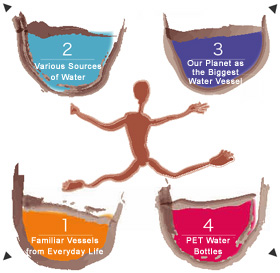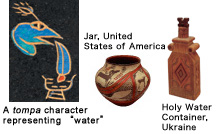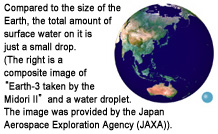Water and Vessels-From Cupped Hands to the Planet


|
Responding to their natural environment, people have used underground water, rainwater, and rivers as water sources. Also, people have built reservoirs, dams, wells, and water channels in order to bring water from its source to the world we live in. Yet, people have had a deep reverence for the water sources that bring forth their blessings, which have led to the development of myths, legends and rituals. Sources of water are the invisible points of contact that connect nature and the real world. |
Our planet Earth is a “water planet” covered by oceans, which account for 70% of its surface, and it is surrounded by the atmosphere, which contains water vapor. However, humans are able to use only a mere fraction of the water that our planet brings forth. Also, surface and underground water is not equally present everywhere. There are places that have it and those that do not, and there are times when it is present and times when it is not. This is due to the Earth's water, including the water vapor in the atmosphere, existing in a giant “stream,” which is called ”the water cycle.” |
|
|
|
 |
|


 In order to ensure that they have water, people have created various vessels to replace their cupped hands. Using the water resources found in their local environment, people carry water from the source to their mouths using vessels which “draw,” “collect,” “scoop,” “pour,” and “carry” water. Following water to its source, the National Museum of Ethnology will present the world of familiar vessels in daily life from its collection. Along with the local natural environment and technology, culture and society are reflected in water vessels from around the world.
In order to ensure that they have water, people have created various vessels to replace their cupped hands. Using the water resources found in their local environment, people carry water from the source to their mouths using vessels which “draw,” “collect,” “scoop,” “pour,” and “carry” water. Following water to its source, the National Museum of Ethnology will present the world of familiar vessels in daily life from its collection. Along with the local natural environment and technology, culture and society are reflected in water vessels from around the world. Water in PET (polyethylene terephthalate) bottles, which can be encountered everywhere, can be said to be a symbol of modern society. Therefore, we attempted to collect PET bottles from all over the world, but since they all contain “water,” it is difficult to manifest the difference one from another, and one can see how countries struggle to show the differences in “water.” At the same time, a lot of ingenuity has gone into mastering the use of this new vessel, and a new relationship between people and water has been born, thanks to the PET bottle.
Water in PET (polyethylene terephthalate) bottles, which can be encountered everywhere, can be said to be a symbol of modern society. Therefore, we attempted to collect PET bottles from all over the world, but since they all contain “water,” it is difficult to manifest the difference one from another, and one can see how countries struggle to show the differences in “water.” At the same time, a lot of ingenuity has gone into mastering the use of this new vessel, and a new relationship between people and water has been born, thanks to the PET bottle.




